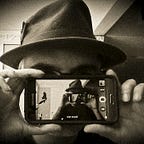Questions for David Ingraham
I’m in awe of David’s work for several reasons:
He is a street photographer. I’ve always felt that street photography is the bravest form of photography; you actually have to leave your house and interact with human beings.
His technical mastery. I cannot emphasize enough how technically difficult his work is. The composition of his works are breath taking. His use of light and shadow to tell stories is masterful. But what I gravitate most to is his vision- to be able to take ordinary life and see it in such a way is genius.
David Ingraham is a Los Angeles-based photographer and musician. Born in Oregon and raised in Michigan, David has had a camera in hand ever since childhood. But it wasn’t until his mid-thirties that he began to take photography more seriously as an art form, studying the work of the greats while striving to forge a strong, recognizable style he could call his own.
David’s work has been presented in numerous publications such as the Los Angeles Times, Black & White Magazine, American Photo, as well as David Alan Harvey’s Burn Magazine. His images have been exhibited worldwide, from Paris and Istanbul, New York and Toronto, to Los Angeles.
David has made the iPhone his camera of choice since 2010.
instagram.com/dayzdandconfuzd
1) Why do you use a cellphone in your work? What does it allow you to do that a traditional camera does not?
As a street photographer, the iPhone provides me with a level of inconspicuousness that I wasn’t able to achieve with a larger camera, so it’s easier to grab shots while going relatively unnoticed. Everyone’s got a smartphone these days, so I just blend in with the crowd. And I’m able to shoot, process, and post an image all from the palm of my hand, so it’s greatly streamlined my workflow.
2) How is mobile photography different from traditional photography? is it a different art form?
I really don’t think there is a difference. As has always been the case, it’s not about the gear, it’s about the imagery. All the elements that apply to good photography — composition, light, timing, content — apply to mobile photography. It doesn’t matter what a person chooses to shoot with, you’re either taking good photos or you’re not; fancy gear won’t change that.
3) What do you wish your cellphone could do that it currently cannot?
I wish I could get a really shallow depth of field and real bokeh, like you’d get with a 50mm 1.4 lens. That’s the only thing I really miss about shooting with a more traditional camera. I frequently end up trying to recreate that look in post processing using various apps. Of course now, with the latest phones, they have portrait mode that gives you the fake shallow depth of field but it seems very hit-or-miss. Sometimes it looks good, other times it looks really phony.
4) What do you see as the future of mobile photography?
I think the novelty will wear off and eventually it won’t be anything special or unusual. That’s already happening to some degree, partly due to the fact that a lot of real photojournalism is being done with smartphones, and of course due to the ubiquity factor: everybody has a smartphone and for many people, that’s their only camera, so it’s made photography that much more accessible to the average person. Everybody’s doing it!
5) What should people read / view / listen to to better understand mobile photography?
I’m not sure an understanding of mobile photography is as important as an understanding of photography in general. What I suggest to students when I do workshops is to find what it is that turns you on, photographically speaking, and what genre you feel you’re able to most express yourself through, and then study the work of the greats within that genre. Really immerse yourself in great photography, collect photography books, get a firm understanding of composition, really get to know light, and then try and build a strong body of work within that genre or style. And then if you decide that you want to shoot with your smartphone as your camera of choice as I have, well that’s fine.
6) Who are your major influences / who do you follow in terms of mobile photography?
Koci Hernandez has been a big influence. He was at the forefront of the mobile photography movement from the very beginning. But most of my influences come from outside of the mobile photography world: Henri Cartier Bresson, Alex Webb, Josef Koudelka, Robert Frank, Harry Callahan, Ray K. Metzker, W. Eugene Smith, Saul Leiter, Trent Parke, just to name a few. It was the work of the old-school photographers that helped shape the way I see photographically, and then I try and apply that to what I do with the iPhone. So I’m approaching photography from a traditional standpoint but using the modern-day technology of the smartphone. The best of both worlds, I like to think.
